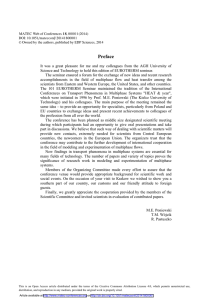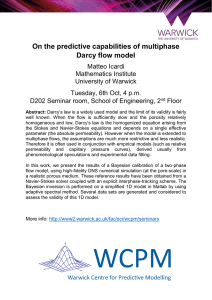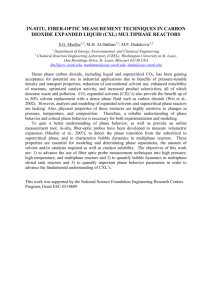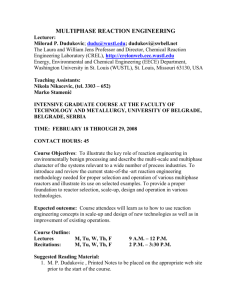Document 14246170
advertisement
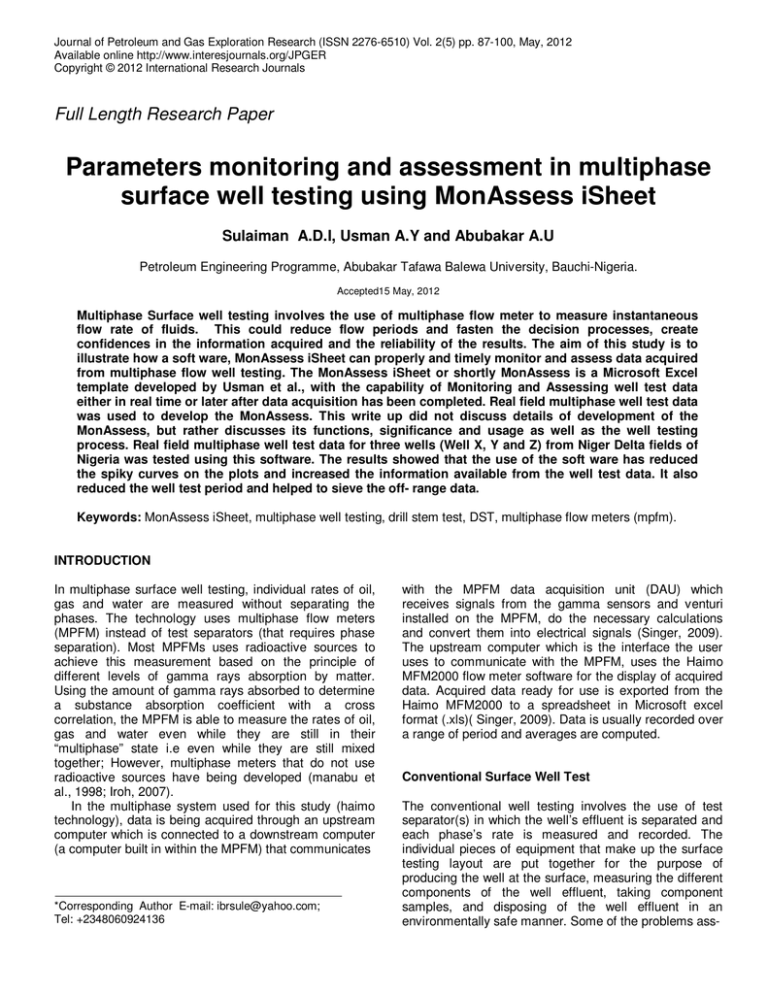
Journal of Petroleum and Gas Exploration Research (ISSN 2276-6510) Vol. 2(5) pp. 87-100, May, 2012 Available online http://www.interesjournals.org/JPGER Copyright © 2012 International Research Journals Full Length Research Paper Parameters monitoring and assessment in multiphase surface well testing using MonAssess iSheet Sulaiman A.D.I, Usman A.Y and Abubakar A.U Petroleum Engineering Programme, Abubakar Tafawa Balewa University, Bauchi-Nigeria. Accepted15 May, 2012 Multiphase Surface well testing involves the use of multiphase flow meter to measure instantaneous flow rate of fluids. This could reduce flow periods and fasten the decision processes, create confidences in the information acquired and the reliability of the results. The aim of this study is to illustrate how a soft ware, MonAssess iSheet can properly and timely monitor and assess data acquired from multiphase flow well testing. The MonAssess iSheet or shortly MonAssess is a Microsoft Excel template developed by Usman et al., with the capability of Monitoring and Assessing well test data either in real time or later after data acquisition has been completed. Real field multiphase well test data was used to develop the MonAssess. This write up did not discuss details of development of the MonAssess, but rather discusses its functions, significance and usage as well as the well testing process. Real field multiphase well test data for three wells (Well X, Y and Z) from Niger Delta fields of Nigeria was tested using this software. The results showed that the use of the soft ware has reduced the spiky curves on the plots and increased the information available from the well test data. It also reduced the well test period and helped to sieve the off- range data. Keywords: MonAssess iSheet, multiphase well testing, drill stem test, DST, multiphase flow meters (mpfm). INTRODUCTION In multiphase surface well testing, individual rates of oil, gas and water are measured without separating the phases. The technology uses multiphase flow meters (MPFM) instead of test separators (that requires phase separation). Most MPFMs uses radioactive sources to achieve this measurement based on the principle of different levels of gamma rays absorption by matter. Using the amount of gamma rays absorbed to determine a substance absorption coefficient with a cross correlation, the MPFM is able to measure the rates of oil, gas and water even while they are still in their “multiphase” state i.e even while they are still mixed together; However, multiphase meters that do not use radioactive sources have being developed (manabu et al., 1998; Iroh, 2007). In the multiphase system used for this study (haimo technology), data is being acquired through an upstream computer which is connected to a downstream computer (a computer built in within the MPFM) that communicates *Corresponding Author E-mail: ibrsule@yahoo.com; Tel: +2348060924136 with the MPFM data acquisition unit (DAU) which receives signals from the gamma sensors and venturi installed on the MPFM, do the necessary calculations and convert them into electrical signals (Singer, 2009). The upstream computer which is the interface the user uses to communicate with the MPFM, uses the Haimo MFM2000 flow meter software for the display of acquired data. Acquired data ready for use is exported from the Haimo MFM2000 to a spreadsheet in Microsoft excel format (.xls)( Singer, 2009). Data is usually recorded over a range of period and averages are computed. Conventional Surface Well Test The conventional well testing involves the use of test separator(s) in which the well’s effluent is separated and each phase’s rate is measured and recorded. The individual pieces of equipment that make up the surface testing layout are put together for the purpose of producing the well at the surface, measuring the different components of the well effluent, taking component samples, and disposing of the well effluent in an environmentally safe manner. Some of the problems ass- 88 J. Pet. Gas Explor. Res. Figure 1. A typical conventional surface well testing layout Figure 2. A typical multiphase surface well testing layout ociated with this process include poor fluid separation, flow instability and poor metal calibration. In addition, flow measurements the resolution to identify small flow events or transient behavior because of the large vessel to separate the fluids phases. The basic elements on a typical conventional surface testing can be seen in figure. 1 above: coefficient with a cross correlation, the MPFM is able to measure the rates of oil, gas and water even while they are still in their “multiphase” state. Multiphase meters are used both topside and subsea to measure the flowing conditions; pressure, temperature, volume flow rates of oil, water and gas (Mus et al., 2002). Below is a typical layout for a multiphase surface well testing.(Figure 2) Multiphase Surface Well Testing (MPSWT) METHODOLOGY This type of well testing uses multiphase flow meters in place of test separator for testing of wells. A major difference between the two is that while the well effluent is disposed off after a conventional well test (figure 1), the effluent is channeled back to the wells production line after an MPSWT. This eliminates the need for gauge tank/surge tank, excessive lines (pipes), booms/burners and other equipments that might be required while using a test separator. Another difference is in the principle of measurement; MPFM measures the individual rates of oil, gas and water without separating the phases. Most MPFMs uses radioactive sources to achieve this measurement based on the principle of gamma rays absorption by matter. Using the amount of gamma rays absorbed to determine a substances’ absorption Parameters recorded during the tests used in this study are: gross liquid flow rate (bpd), oil flow rate (bpd), gas flow rate (mscfpd), water flow rate (bpd), basic sediments and water (BS&W) (%), Gas volume fraction (GVF) (%), o flow line temperature ( C), flow line pressure (psi), tubing head pressure (psi) and the gas oil ratio (scf/bbl). The system of multiphase well testing technology used for data acquisition that is used in this study provides the final test output on a spreadsheet in Microsoft excel xls format. For the monitoring aspect, excel codes were developed and used to determine and record the maximum and minimum entries in each recorded parameter, pinpoint the cell location of the maximum and minimum entries, determine the amount of “offrange” entries (off-range values to be defined by the user, Sulaiman et al. 89 Figure 3. Diagrammatic expression of the MPFM operating principle6 Figure 4. The haimo MFM2000 flow meter data acquisition interface (source: Haimo MFM2000) creating an “approximated form” mirror image of the entire data sheet of the well test result (approximirror) and plotting them (for each parameter) against time of data acquisition and determine the statistical mode (the entry that appears most in the approximated data) of each recorded parameter. The acquired data, excel codes were developed and used to determine the standard deviation of each recorded parameter, the statistical range of each recoded parameter, the amount of “off-range” entries (off-range values to be defined by the user) and Plot the approximated well test result for relevant parameters against time of data acquisition (approxiplots). All these above are conglomerated into one excel sheet that performs the entire listed functions effectively and is named the “MonAssess iSheet”, (Monitoring and Assessment Interactive Sheet). Measurement Principles in Multiphase Well Testing The MPFM is designed to measure the volumetric flow rates of oil, water and gas of a producing well at flow line conditions. Flow rates at line condition were converted to Standard Conditions with a PVT Package. Measurement process used by Haimo tech (2008) was adopted for this work as shown in figure 3 above: Data Acquisition and the Raw Well Test Data Data was acquired through an upstream computer (service computer) which is connected to a downstream computer (a computer built in within the MPFM) that communicates with the MPFM data acquisition unit (DAU). The DAU receives signals from the gamma sensors while the ventury installed on the MPFM do the necessary calculations and convert the data into electrical signals. The upstream computer which is the interface the user uses to communicate with the MPFM uses the Haimo MFM2000 flow meter software to display the acquired data. The interface for the display of the acquired data (or data under acquisition) is shown below: Figure 4 above shows the ideal state of the haimo MFM2000 flow meter data acquisition interface, the top left black region displays the “test result chart” where 90 J. Pet. Gas Explor. Res. Figure 5. Raw well test data sheet (WTDS) showing acquired data. Figure 6. Production Plot for well X (raw) graphical plots of the recorded data are displayed against time. Each parameter is given a line colour that represents its curve on the plot. Definitions of the line colours were given next to the chart under “curve view”. Next after the curve view on the top right is the “Well ID” where the name of the well under test is displayed. And as test was completed, the final test result is exported from the Haimo MFM2000 software to a spreadsheet in Microsoft excel format as shown above: In Figure 5, the acquired data by the MPFM is shown as exported from the haimo MFM2000 software at standard conditions; the well ID is shown as WELL XXX. Entries were recorded per minute and extend for hours, however a preliminary test is carried out (for about 2hrs) for the system to stabilize before main test commences. Averages of the recorded parameters are shown in the green colored cells. Using this raw data, Production Plot for well X (raw) can be seen above: RESULTS AND DISCUSSION Figure below shows the raw data copied from (figure 5) and inputted into the MonAssess.obtained(Figure 6) The above figure shows how well X data looks like after put into the MonAssess, MODE(APPROXIMATED) and the Plots cannot be used until after the APPROXIMI- Sulaiman et al. 91 Table 1. Interactive inputs into the MonAssess for well X APPROXIMIRROR S.F LOWER LIMIT OF WITHIN-RANGE UPPER LIMIT OF WITHIN-RANGE Gross Liquid 2 Oil Flow 2 Water Flow 2 Gas Flow 2 BS&W GVF FLT FLP THP GOR 1 1 1 2 2 2 430 95 380 130 50 75 20 200 350 1100 520 120 430 200 90 85 50 250 450 2000 Figure 7. THP, FLP & FLT plots for well X (raw) Figure 8. GOR plot for well X (raw) RROR S.F are inputted. PERCENTAGE OF ENTRIES </> also need to be defined to get the off-range percentages. Inputs were therefore made into the MonAssess correspondingly as shown in the table 1 above. Inputting the values in the above table correspondingly into the MonAssess yields the following results (the well is also identified):(Figure 7 and 8) Taking the Oil flow in Figure 6 for interpretation; the standard deviation is 26.84, comparing this with the ave- 92 J. Pet. Gas Explor. Res. Figure 9. Well X data inputted into the MonAssess. Figure 10. The MonAssess showing result for Well X rage flow of 100.86bbl/d, this shows a great amount of discrepancy in the tested result. This can be testified by reading the RANGE which reads 134.10 (an amount even much greater than the average). It can be seen that the MINIMUM entry is 0.44 recorded at cell D22 and the Maximum is 134.54 recorded at cell D80. The mode which reads 110 is in this case, a much reliable description of the well oil flow. Also the MonAssess shows that there are much entries that are off the predefined limit of 95 to 120bbl/d; 19.78% of the entries are above 120 and 30.77% are below 95bbl/d. The remaining Parameters could also be interpreted in similar manner.(Figure 9 and 10) Above are the Approxiplots obtained (compare the plots with the corresponding raw plots in figures 6, 7 and 8 respectively to see the rectification achieved. Degree of rectification could even be increased by reducing the APPROXIMIRROR S.F to 1 for the prod- Sulaiman et al. 93 Figure 11. Production Approxiplot for well X Figure 12. THP, FLP & FLT Aproxiplots for well X Figure 13. GOR plot for well X uction parameters):(Figure 11,12 and 13) Reading the TEST DURATION 1.52hrs, it can be understood that this result is for a preliminary test hence the discrepancies. However, the test result can also be 94 J. Pet. Gas Explor. Res. Figure 4.12. Well X1 data after refining on the MonAssess iSheet Table 2. Averages before and after refining for well X1 Parameter Average before refining Average after refining change Gross Liquid Oil Flow Water Flow Gas Flow 497.17 100.89 396.28 161.23 BS&W 79.87 GVF 78.85 FLT 39.44 FLP 213.94 THP 407.03 GOR 7119.53 500.4 106.47 393.93 163.38 78.77 79.04 39.5 213.23 408.72 1554.27 -3.23 -5.58 2.35 -2.15 1.1 -0.19 -0.06 0.71 -1.69 5565.26 refined by discarding some of the off-range entries in the MonAssess as shown in Figure 4.12 above: The table 2 above shows the respective averages of the recorded parameters before and after refining. By discarding some of the off-range entries in Well X1 data, it can be seen how the averages of the parameters changed (this is more apparent in the GOR reading that dropped by 5565.26scf/bbl). There are also changes in the Approxiplots, the outrageous spikes are eliminated. Below are the production approxiplots after the refinining: CONCLUSION The MonAssess iSheet can handle any multiphase well test data (all length of well test, up to 100hrs data) once in the format of the Haimo MFM2000 software. For parameters of large size and high degree of fluctuation (e.g as in GOR of well Z shown in Appendix) rectification is not achieved rather the curve is “discretized” (i.e spikes peaking at regular intervals) which still offers better readability. The developed package is not only for field application to monitor and assess multiphase surface well test data but also for other purposes (such as data refining). REFERENCES Iroh BC (2007). “Bell Oil & Gas Limited Well Testing Procedures” December. Leggett RB, Boding DC, Power BS, Shehata k, Halvorsen M (1996). “multiphase flow meters successfully measures three pahse flow at extremely high gas volume fractions-Gulf of Suez, Egypt” SPE 36837 presented at the 1996 European petroleum conference held in Milan, Italy 22-24 october. Manabu F, Yoshiaki T, Tomomi N and Daisuke Y (1998). “Development of a Multiphase Flowmeter without Radioactive Source” presented at the 1998 Offshore Technology Conference held in Houston, Texas, 4-7 May. Mus EA, Toskey ED, Bascoul SJF, Norris RJ (2002). “Added Value of a Multiphase FlowMeter in Exploration Well Testing”. SPE Production and Facility J. PP197-203. Singer James (2009). "Statistics." Microsoft® Encarta® [DVD]. Redmond, WA: Microsoft Corporation, 2008. Sulaiman et al. 95 APPENDIX 1. WELL Y Figure A1. Raw production plots for well Y. Figure A2. Production Approxiplots for well Y 96 J. Pet. Gas Explor. Res. Appendix cont. Figure A3. THP, FLP & FLT raw plots for Well Y. Figure A4. THP, FLP and FLT Approxiplots for well Y Sulaiman et al. 97 Appendix cont. Figure A5. GOR raw plot for Well Y. . Figure A6. GOR Approxiplot for well Y Making inputs similar to that shown for well X in the MonAssess, the following are obtained for well Y: The general output can be read from the MonAssess iSheet tab shown in Fig 5.5. However the approxiplots turned out with spikes but still offers more readability as the spikes are discrete (for the GOR Approxiplot, no much rectification is achieved). 98 J. Pet. Gas Explor. Res. Appendix cont. 2. WELL Z Figure B1. production plots for well Z (raw). Figure B2. Production Approxiplots for well Z Sulaiman et al. 99 Appendix cont. Figure B3. THP, FLP & FLT raw plots for Well Z. Figure B4. THP, FLP & FLT Aproxiplots for Well Z 100 J. Pet. Gas Explor. Res. Appendix cont. Figure B5. GOR raw plot for Well Z. Figure B6. GOR Approxiplot for well Z.
